I have a little wonderland in my backyard. Among this happy place, dragonflies hover, rabbits abound, squirrels cavort, and a few dozen bird species flutter about. I love birds, but I do have my favorites. I love chickadees and owls. I think blue jays have gorgeous markings. The plain little house wren with its pot belly is adorable. But I’ve been fascinated by one particular bird species for as long as I can remember: the American crow. I have managed to “make friends” with a few (though neither they nor I feel like spending time together in this exhausting summer heat).
My paternal grandmother used to feed crows with whatever bread pieces and scraps she had. Since that time, when my little eyes saw those crows enjoying her gifts, I have loved these mystical birds.
I remember the first time I became determined to make friends with crows. I came to feed them every day at the same time. When I approached, I directed a congenial “hello” to a crow perched on a tree. The crow seemed surprised that I, a human, would take note of and greet it.
So, I thought it would be nice if I shared some information with our readers about this wonderful, intelligent, bright, beautiful bird – the American crow.
Basic info
-
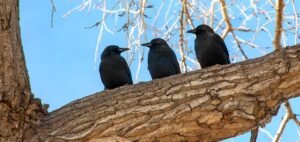
“Three’s a Crowd,” American Crows, Sheila Sund – Wikimedia Family: Corvidae (includes jays, magpies, and nutcrackers)
- Genus: Corvus (includes crows, ravens, and rooks)
- American crow: Corvus brachyrhynchos
- Color: All black, head to toe
- Male to female difference: males are larger than females
We often don’t notice how prevalent crows are in our lives. They live in every region of the world except Antarctica. The most common crows in the United States are the American crow and the fish crow. American crows reside all across North America and as far south as Bermuda. Their population is approximately 31 million.
Crows measure around 17.5 inches and can weigh anywhere from 12 ounces to over 3 ½ pounds. They are larger in the eastern United States with the exception of Florida. Crows in that state are small with bigger feet.
The crow flies “with a distinct rowing motion, sometimes incorporating glides.”1)The Cornell Lab All About Birds “American Crow Identification” They caw in flight. Everyone recognizes their birdsong. Scientists have recorded around 15 to 33 different caws/ calls. Ornithologists are continuing to research crow language. Male crows seemingly have a more throaty, rattling call. Their caws have dialects, which shouldn’t be surprising. In the United States, our primary language is English. Just like we speak differently from region to region, crows “have a deviation in their aviation language . . .”2)Treehugger “9 Uncanny Facts About Crows” by Russell McLendon December 15, 2022
On average, crows live for about seven to fourteen years in the wild. Life expectancy is longer in captivity.
Habitat
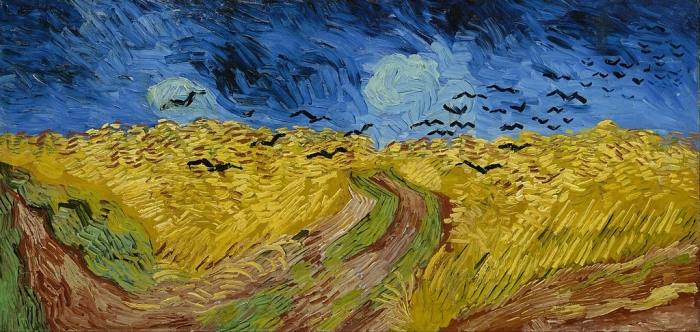
Crows like fairly open places, like woodlands, farms, or even towns. They will live anywhere, really, as long as they have plenty of shelter and trees, though they do not like hot temperatures. They have adapted well to our neighborhoods and city parks. They nest in the same place every year, usually high in a tree, up to seventy feet above ground.
Sociability and Intellect
Crows are known for being highly intelligent, analytical, and communicative. They are one of the smartest in the animal world, “on par with chimpanzees.”3)Audubon.org “10 Fun Facts About the American Crow” by Rachel Fritts August 25, 2021 They use tools like sticks and wire to get at food sources. To crack open nuts, crows will sometimes drop them on the road for cars to run over. They pay close attention to crosswalk signs and will only retrieve “the nut when the crosswalk sign is lit.”4)ThoughtCo. “9 Ways Crows Are Smarter Than You Think” by Anne Marie Helmenstine, Ph.D. June 22, 2019
They apparently talk about us with other crows. They watch and learn from us, and can even imitate us. And they never forget a face. They remember kind faces, but they especially brand a mean person’s face in their minds forever. They hold grudges, too, and warn other crows about an awful person, thus fostering the resentment for that person for generations. They sometimes harass the mean person whose face they recognize. Overall, they can be very friendly (or indifferent) to humans.
American crows will stand on anthills and let the ants climb on it. Then, the bird will rub the ants into their feathers. This behavior is called anting and is used to ward off parasites. Ants can also cause birds to get drunk from the formic acid released from the ant’s bodies.5)LiveScience.com “Facts About Crows” by Alina Bradford May 2, 2017
Noise (windchimes, swinging gates, creaky doors) scares them. Other sources say they do like bright things and have “an aesthetic vision: Hence, bright, shiny, and colorful things get the attention of these birds.”6)Love the Birds “How to Attract Crows: Foolproof Guide to Befriend Them” by Brandon Trent n.d.
Crows place sentinels in various places who alert other crows (and other birds, for that matter) about danger. Sentinels are easy to pick out. If a group of crows are feeding, the sentinel is watching in a tree above them. They can be aggressive, especially when it comes to birds of prey, like hawks or owls. The reader has no doubt seen a crow chasing away a hawk.
Courtship, nesting, and family life
Crow courtship is a ritual. The male stands in front of the female, “fluffs up body feathers, partly spreads wings and tail, and bows repeatedly while giving a short rattling song.” The male also engages in “diving flight displays” 7)Washington Department of Fish & Wildlife “Living with Wildlife: Crows” to impress and chase the ladies. The mates are very affectionate. They draw close, touch each other’s bills, and groom each other. They mate for life, but are not necessarily monogamous. Perhaps better stated, they are “socially monogamous but genetically promiscuous.”8)Treehugger “9 Uncanny Facts About Crows” by Russell McLendon December 15, 2022
. . . they generally stay with one partner for life, but genetic analyses show that male crows only father about 80% of their family’s offspring.9)Treehugger “9 Uncanny Facts About Crows” by Russell McLendon December 15, 2022
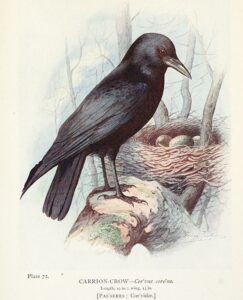
Both genders build a nest, usually in the fork of a tree or near a solid branch touching the trunk. Nests are around 1½ to 2 feet long. They are usually built in the springtime and are made from “branches, twigs, hair, twine, bark, plant fibers, mosses, cloth,”10)LiveScience.com “Facts About Crows” by Alina Bradford May 2, 2017 mud, etc. They are typically lined with softer materials. Crows sometimes build decoy nests to keep away predators. They don’t nest on the ground and rarely nest on buildings. An interesting side note to crows’ nests:
Hawks and owls inhabit old crow nests; raccoons and tree squirrels use them as summer napping platforms.11)Washington Department of Fish & Wildlife “Living with Wildlife: Crows”
Crow eggs are around two inches long and a dull greenish-gray color with brown speckles. The female incubates them for almost three weeks. Both parents feed the hatchlings and sometimes older siblings feed and care for them, too. So, care for the young is largely a family endeavor.
Life outside the nest begins at four or five weeks, then the young crow stays near the family unit. A crow’s family unit is very close and can include several generations. The mother and father continue to feed the fledglings until they reach about two months old. Eventually, the young crow has to decide if he or she will stay with the family unit or venture on their own to find a mate or establish territory.
When nesting season has ended, a crow family will night roost with a murder, numbering in the “hundreds or even thousands.”12)Washington Department of Fish & Wildlife “Living with Wildlife: Crows” These perches allow them to be safe and warm. They are also centers of information and hookup places to find a mate. These roosts are maintained year after year.
Food
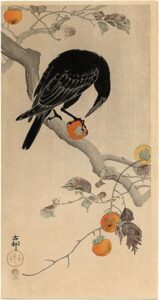
Crows are omnivores who mostly feed on the ground. They are scavengers, so one might see them near roadkill or garbage dumps. In towns and cities, crows have learned exactly when restaurants throw out their trash, or when garbage pickups are. In non-breeding season, a crow will fly “as far as 40 miles each day from evening roost sites to daytime feeding areas.”13)Washington Department of Fish & Wildlife “Living with Wildlife: Crows”
Once a crow catches food, the bird takes note of its surroundings. If another animal has noticed, the crow will pretend to bury the food but “stash it in its feathers,”14)ThoughtCo. “9 Ways Crows Are Smarter Than You Think” by Anne Marie Helmenstine, Ph.D. June 22, 2019 then go elsewhere.
Crows also steal food from other animals. Sometimes, they covertly follow an animal back to their abode and rob them of their food or even eggs. They’re crafty when drawing animals away, too:
In one case, a group of American crows was seen distracting a river otter so they could steal its fish . . . while another group followed common mergansers to intercept minnows the ducks had been chasing into shallow water.15)Treehugger “9 Uncanny Facts About Crows” by Russell McLendon December 15, 2022
Sometimes they even care for the elderly or infirm crows in their unit:
Harvey McNairn, Toronto, Canada: “Some time ago I found an old Crow that had become blind, and afterward heard of several other similar cases; judging from the fuss the others made and the bird’s sleek appearance, he had been fed by his comrades.16)The American Crow by Frank L. Burns. 1895. Internet Archive.
Crows don’t typically visit bird feeders, though they do love peanuts and corn. They also love “crackers, nuts . . . hard-boild eggs, and some meat.”17)Love the Birds “How to Attract Crows: Foolproof Guide to Befriend Them” by Brandon Trent n.d. They will come to platform feeders for these foods. To attract crows to your yard, first offer them food. Feed them daily in the same place at the same time.
Death
A murder surrounds a dead or dying crow, mostly to determine what has befallen their comrade. Some scientists believe this behavior is “closer to reconnaissance.”18)Audubon.org “Think Crow Funerals Are Strange? Wait Until You See the Wake” by Jason Bittel July 23, 2018 Crows loudly “discuss” what’s happened. If the crow was killed by a predator, the murder will aggressively surround and mob the creature.
During a crow funeral, the birds gather together in the trees. As the minutes pass, more crows flock to the scene, cawing intensely. It’s intimidating when the crows shriek at their deceased member and bystanders. The crows fly away, but if they see the person associated with the death of their friend or family member, they resort to mobbing behaviors again.19)Cake “What Happens During a Crow Funeral?” by Klaudia Krystyna May 11, 2022
The group will avoid the area where the crow was found dead, even at the cost of a food source. If humans are around the dead crow, the murder will associate them with the death.
Some funerals are silent vigils where crows might adorn the dead crow with sticks or weeds. Other funerals are odd and cringeworthy. Some crows engage in necrophilia and cannibalism. Sources indicate these acts might be during mating season where “the crows lose their sense of self-control due to their hormones.”20)Cake “What Happens During a Crow Funeral?” by Klaudia Krystyna May 11, 2022
In a startling display, some crows approach the deceased and mate with the body. They may also attack the deceased crow, dragging and pecking it.21)Cake “What Happens During a Crow Funeral?” by Klaudia Krystyna May 11, 2022
Mythology and Symbolism
Crows appear in many tales and mythologies. In certain mythos, they are the gods’ messengers. Folklore often portrays crows as tricksters. While believed to be a source of divination or prophecy, crows are also seen as bad omens. They have been associated with death for centuries. One reason may be because “crows would circle a battlefield, waiting for soldiers to die and feast on their bodies.”22)Cake “What Happens During a Crow Funeral?” by Klaudia Krystyna May 11, 2022
The crow symbolized creation for the Celts. In Celtic mythology, the Morrighan sometimes appears in the form of a crow or raven. Sometimes she is escorted by three crows. Crows signified that Morrighan is either keeping an eye on everyone or coming to visit someone.
In Welsh tales, the crow is a death omen. Welsh tales also say witches can shapeshift into crows and fly away. In Norse mythology, the god Odin had two messenger crows by him. China once worshipped a sun crow with three legs, as a “symbol of solitude.”23)Ted Andrews, Animal Speak
The ancient Greeks and Romans were really into augury (bird divination). They saw the crow as a symbol of Apollo’s prophesy.24)Apollo is Zeus’s son and quite a complex deity. He is a god of archery, entertainment, prophecy, healing, light, poetry, etc. After his mistress betrayed him, he turned her into a crow.
Crows are good luck charms for Native Americans. Some tribes also “use crow imagery in their death rituals and customs . . . Some tribes even celebrate their deceased ancestors as crows.”25)Cake “What Happens During a Crow Funeral?” by Klaudia Krystyna May 11, 2022
Appalachia has its own crow lore and superstition. Sickness is around the corner if a murder of crows flies low. If a single crow flies over a house and caws three times, someone in that family will soon die. A crow cawing in the morning in otherwise silence means rain is coming. It’s bad luck if a person sees a single crow on a field. Seeing two crows is good luck. Three means health and four means wealth. Five crows mean someone will be sick. Six means death is coming. It’s also bad luck to kill a crow.
Conclusion
For me, I think I prefer looking at crows the way Ted Andrews does in his comprehensive book Animal Speak: The Spiritual & Magical Powers of Creatures Great and Small:
Wherever crows are, there is magic. They are symbols of creation and spiritual strength. They remind us to look for opportunities to create and manifest the magic of life. They are messengers calling to us about the creation and magic that is alive within our world everyday and available to us. (p. 132)
The next time you see a crow on a light pole in a parking lot, remember that’s likely a sentinel. And, if you hear crows cawing to one another as you walk by, you might ask yourself “Are they talking about me?” Then, perhaps, acknowledge them . . . and smile.
Sources:
- Animal-Speak: The Spiritual & Magical powers of Creatures Great & Small by Ted Andrews. St. Paul. Llewellyn. 1988
- Audubon.org “10 Fun Facts About the American Crow” by Rachel Fritts August 25, 2021
- Audubon.org “American Crow” Guide to North American Birds
- Audubon.org “How to Tell a Raven from a Crow” by Birdnote October 22, 2012
- Audubon.org “Think Crow Funerals Are Strange? Wait Until You See the Wake” by Jason Bittel July 23, 2018
- Birds&Blooms “American Crow: Everything You Should Know” by Emily Hannemann January 9, 2023
- The American Crow by Frank L. Burns. 1895. Internet Archive.
- Cake “What Happens During a Crow Funeral?” by Klaudia Krystyna May 11, 2022
- The Cornell Lab All About Birds “American Crow Identification”
- The Cornell Lab of Ornithology, Macaulay Library
- Factsite “30 Facts About Crows That’ll Have You Caw-ing For More” by Luke Ward January 14, 2023
- The American Crow and the Common Raven. Lawrence Kilham. College Station, Texas A&M. 1989.
- Learn Religions. “The Magic of Crows and Ravens.” By Patti Wigington. Updated on January 12, 2020
- LiveScience.com “Facts About Crows” by Alina Bradford May 2, 2017
- LiveScience.org “Why Crows Hold Funerals” by Mindy Weisberger January 6, 2016
- Love the Birds “How to Attract Crows: Foolproof Guide to Befriend Them” by Brandon Trent n.d.
- ThoughtCo. “9 Ways Crows Are Smarter Than You Think” by Anne Marie Helmenstine, Ph.D. June 22, 2019
- Treehugger “9 Uncanny Facts About Crows” by Russell McLendon December 15, 2022
- Treehugger “Crows Have a Human-Like Grammar Skill, Scientists Find” by Treehugger Editors
- Washington Department of Fish & Wildlife “Living with Wildlife: Crows”
- YouTube
**Featured image: Jen Uppend, Unsplash
References
| ↑1 | The Cornell Lab All About Birds “American Crow Identification” |
|---|---|
| ↑2, ↑8, ↑9, ↑15 | Treehugger “9 Uncanny Facts About Crows” by Russell McLendon December 15, 2022 |
| ↑3 | Audubon.org “10 Fun Facts About the American Crow” by Rachel Fritts August 25, 2021 |
| ↑4, ↑14 | ThoughtCo. “9 Ways Crows Are Smarter Than You Think” by Anne Marie Helmenstine, Ph.D. June 22, 2019 |
| ↑5, ↑10 | LiveScience.com “Facts About Crows” by Alina Bradford May 2, 2017 |
| ↑6, ↑17 | Love the Birds “How to Attract Crows: Foolproof Guide to Befriend Them” by Brandon Trent n.d. |
| ↑7, ↑11, ↑12, ↑13 | Washington Department of Fish & Wildlife “Living with Wildlife: Crows” |
| ↑16 | The American Crow by Frank L. Burns. 1895. Internet Archive. |
| ↑18 | Audubon.org “Think Crow Funerals Are Strange? Wait Until You See the Wake” by Jason Bittel July 23, 2018 |
| ↑19, ↑20, ↑21, ↑22, ↑25 | Cake “What Happens During a Crow Funeral?” by Klaudia Krystyna May 11, 2022 |
| ↑23 | Ted Andrews, Animal Speak |
| ↑24 | Apollo is Zeus’s son and quite a complex deity. He is a god of archery, entertainment, prophecy, healing, light, poetry, etc. |
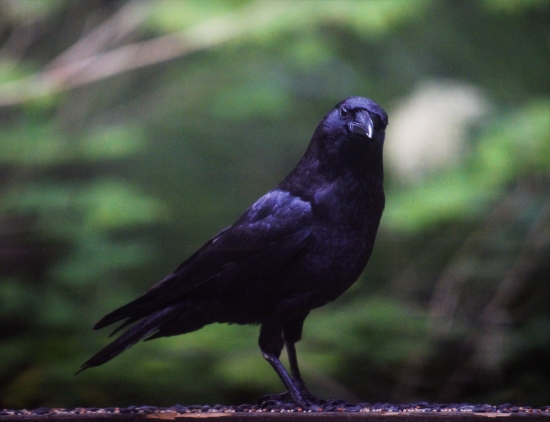







This was a delightful read! I’m currently in Germany, been here for 4 years. I come home for good to Ohio in three weeks. I’ve been missing home a lot, but this cheered me right up. Thank you so much for putting the time and effort into it.